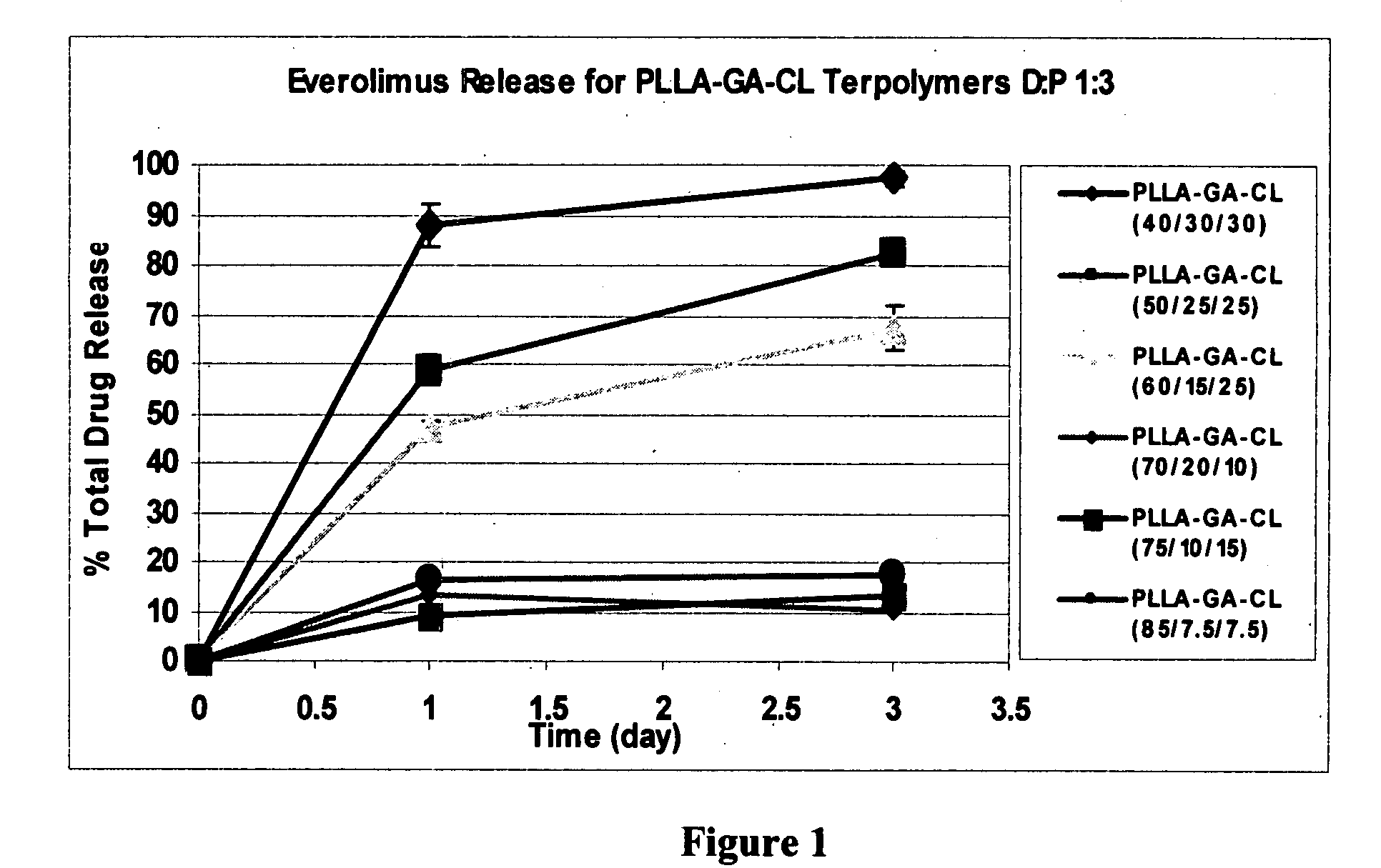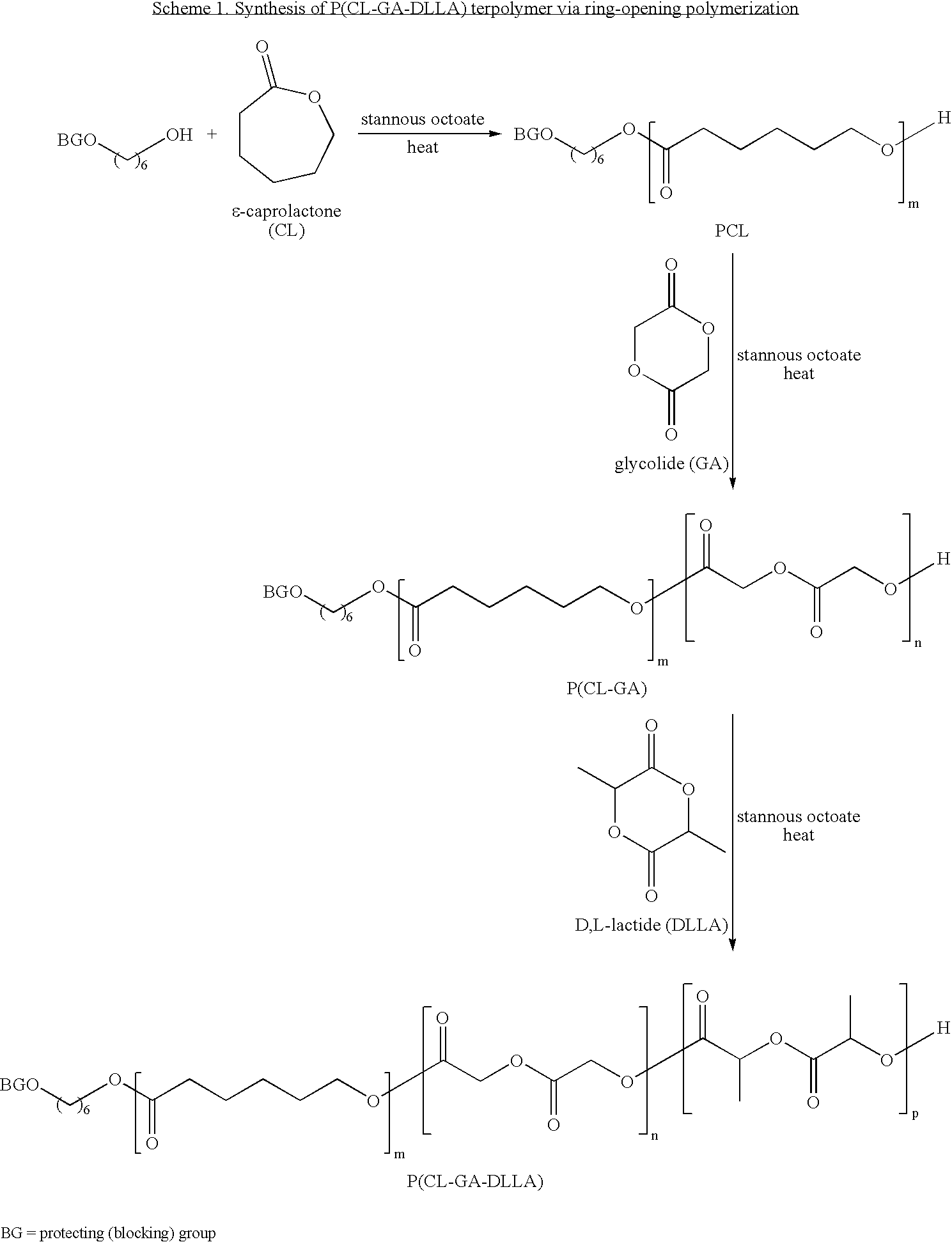Biodegradable polymeric materials providing controlled release of hydrophobic drugs from implantable devices
a biodegradable polymer and drug technology, applied in the direction of drug compositions, prostheses, cardiovascular disorders, etc., can solve the problems of drug-delivery stent late thrombosis, occlusion of conduits, and collapse of inner flaps or torn arterial linings, so as to enhance the permeability of hydrophobic drugs, improve the miscibility of hydrophobic drugs, and improve the effect of drug miscibility
- Summary
- Abstract
- Description
- Claims
- Application Information
AI Technical Summary
Benefits of technology
Problems solved by technology
Method used
Image
Examples
example 1
Controlled release of everolimus from P(DLLA-GA-CL) 60 / 15 / 25
[0241]A primer layer was formed on a stent from a primer solution containing about 2 weight % of P(DLLA-GA-CL) 60 / 15 / 25 (60 molar % DLLA, 15 molar % GA and 25 molar % CL) in 90 / 10 acetone / methyl isobutyl ketone (MIBK).
[0242]A solution containing about 2 weight % of P(DLLA-GA-CL) 60 / 15 / 25 and everolimus, at one of various drug-to-polymer (D:P) ratios, in 90 / 10 acetone / MIBK was prepared. The stent was mounted on a mandrel and spray-coated at a deposition rate of, e.g., about 10-20 microgram / pass. The stent was then dried in an oven at about 50° C. for about 30 minutes to evaporate the solvent. The dosage of everolimus was about 100 microgram / cm2.
[0243]Drug release from the coated stent was analyzed by the “dipping” method. The stent was dipped in 10 mL of 0.1% sodium azide in porcine serum maintained at 37±0.5° C. at a dipping rate of 40. The drug formulation was delivered into the release medium by a diffusion, dissolution a...
example 2
Controlled release of everolimus from P(LLA-GA-CL) terpolymers
[0246]Similar procedures as those above were used to study the release of everolimus from drug-laden stents coated with P(LLA-GA-CL) terpolymers containing various molar percentages of LLA, GA and CL. FIG. 1 depicts the release of everolimus from stents coated with P(LLA-GA-CL) terpolymers, where the D:P ratio was 1:3 and the dosage of everolimus was about 100 microgram / cm2. Table 2 lists some of the results shown in FIG. 1.
TABLE 2Release of everolimus from P(LLA-GA-CL) terpolymers, D:P = 1.3Molar %% Drug Release,% Drug Release,of LLA / GA / CLDay 1 (n = 3)Day 3 (n = 3)40 / 30 / 30 88 ± 4.297.4 ± 1.550 / 25 / 2558.6 ± 3 82.3 ± 2.360 / 15 / 2547.4 ± 1.367.4 ± 4.5
[0247]As can be seen from FIG. 1 and Table 2, stents coated with P(LLA-GA-CL) terpolymers provide controlled release of everolimus, and the drug's release rate can be controlled by adjusting various factor such as the molar % content of the LLA, GA and CL monomer components. Fur...
PUM
| Property | Measurement | Unit |
|---|---|---|
| Temperature | aaaaa | aaaaa |
| Temperature | aaaaa | aaaaa |
| Temperature | aaaaa | aaaaa |
Abstract
Description
Claims
Application Information
 Login to View More
Login to View More - R&D
- Intellectual Property
- Life Sciences
- Materials
- Tech Scout
- Unparalleled Data Quality
- Higher Quality Content
- 60% Fewer Hallucinations
Browse by: Latest US Patents, China's latest patents, Technical Efficacy Thesaurus, Application Domain, Technology Topic, Popular Technical Reports.
© 2025 PatSnap. All rights reserved.Legal|Privacy policy|Modern Slavery Act Transparency Statement|Sitemap|About US| Contact US: help@patsnap.com


